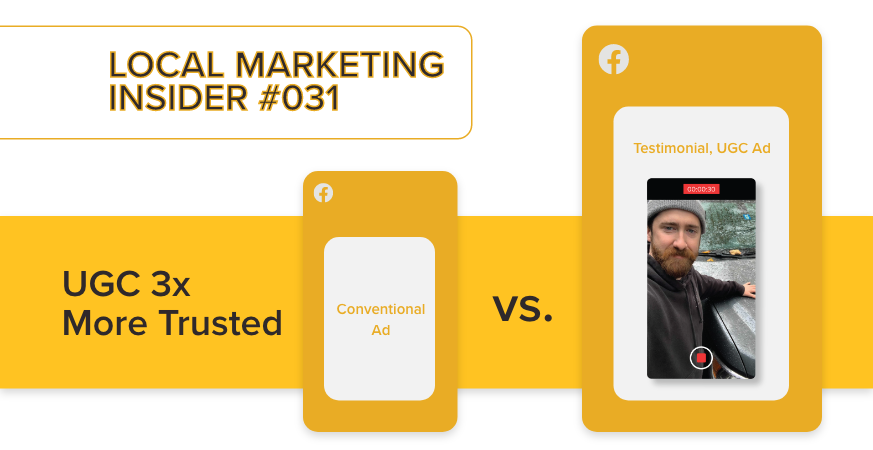-
Products
TechnologyManaged Services
- Resources
- Pricing
- Company
Your customers are fantastic brand advocates. A brand message communicated via past customers is roughly 3x as trusted as the same message communicated via advertising. What if you were to combine the reach and targeting of digital ad spend with the trustworthiness and persuasiveness of reviews?

To preface, this is an unproven strategy. Just a hunch of mine.
Most likely it will be you, the LMI reader, to prove me right (or wrong). But I’m confident this strategy could give you an edge and I have the data to back it up. I’d love to see this in action.
To start, this stat is key: 93% of consumers trust friends/family for product/service recommendations, 91% trust review sites, but only 38% trust advertising.
If you flipped this chart on its head you’d likely get the order in which marketers most commonly allocate their budgets. Advertising gets the most money, down to word-of-mouth.
Yes, advertising is an incredibly direct way to get your brand in front of prospective customers. But it's also a very inefficient way to build trust and effectively communicate the value your business provides. It can be easily tuned out. Or, more importantly, it’s foundationally biased. It’s unapologetically sales-oriented and as a result, does not elicit much trust.
We mention this frequently but it’s worth repeating: today we live in a world of distributed trust. Consumers trust their peers to help them make buying decisions.
Extrapolating a bit on the chart above, a brand message communicated via past customers is roughly 3x as trusted as the same brand message communicated through advertising.
3x.
That caught my attention. Your past customers are fantastic brand advocates. When properly managed, they’re highly efficient messengers. Your past customers are more relatable and are at least perceived to be unbiased.
And according to Widewail data collected from 750,000 customer reviews, on average 88% are positive. That’s a lot of happy customer feedback to have in your marketing toolkit.
Which begs the question, why not extensively use customer reviews and video testimonials to power a trusted, impactful, and presumably, profitable ad strategy? Did someone say ROAS?
Google Agrees, Put People at the Center of your Ads
Last week, Think with Google released a new YouTube ad study looking at thousands of automotive video ads, identifying the top strategies utilized in high-performing ads.
The #2 strategy: Put people in the center of your ad.
“Anchoring your story in human experience allows your audience to imagine the tangible experience of the car, and how it might fit into their lives, building a personal, and more power powerful, connection to your brand.”
And Google is just talking about using actors, not authentic customer experiences. Even in a very competitive space like Automotive, human-centered stories help cut through the noise.
In the context of a local business, the voice of the happy past customer is the logical evolution of this idea. Additionally, the use of self-recorded testimonial video is more authentic and therefore trustworthy, as compared to professionally filmed content. The format itself plays a role in the perceived trustworthiness of the message.
According to Consumer Acquisitions by BrainLabs, user-generated content outperforms conventional ads by up to 50%.
The Strategy:
Use Past Customer Reviews and Videos to Build Trust + Persuasion, Use Technology to Build a Library of Customer Content For Targeted Deployment via Paid Channels
Since we launched Invite Video, and as a marketer myself trying to figure out what’s next for Widewail’s marketing, I’ve been playing around with this question: what is possible, now that a business could have multiple new customer videos coming in per month, instead of per year?
How could we think about utilizing a customer video + review database with unique customer content supporting each product, different geos, demographics, video lengths, and more? Could this be used to build more trust through advertising?
In addition to building trust through customer testimony, building a library of customer review content is the perfect foundation for hyper-targeted and relevant ads.
Further, using your customers as brand ambassadors leverages the behavioral science concept of the self-reference effect - people are more likely to listen or respond to those that are similar to them in some way, be it the product they’re interested in, where they live, age, gender, etc.
For me, the secret sauce here is fully utilizing a large and diverse library of customer content – something most businesses don’t have but is now conceivable with Widewail and other review generation technology partners.
How you could utilize a video testimonial library:
Ideas to segment review content for Property Management groups:
Ideas to segment review content for Automotive dealerships:
Ideas to segment review content for retailers:
To break it down:
+ Automated customer review and video testimonial generation
+ Library of past customer review content, organized by products and customer characteristics
+ Paid media visibility and audience targeting
+ Trustworthiness and persuasiveness of customer content
= Direct, efficient, relevant method for marketing to prospective customers
The reach and relevance of paid ads with the trust of social proof, powered by marketing automation. Certainly at least worth a test.
Market your value propositions via customer reviews
Going back to my earlier point, yes, ads are a very direct way to get your message out to the market and communicating that message via past customers is an efficient way to spread that message, but the question is…what makes your business so special in the first place?
This is where the idea of a value prop comes in. What do you want to be known for? It could be the best selection, reliable communication, the best quality - you get the idea. You likely (hopefully?) already have some idea of what this is for your business.
A focus for us here at Widewail lately has been asking how we can help businesses guide the customer towards leaving a review that helps the business communicate key value props. Put another way, how can we get our customers to reinforce our key value propositions back to us so that we can then go out to the market and communicate that value through the words of our customers? Widewail’s Campaigns feature aims to provide the technology to support this.
Further guiding testimonial content is another way to make sure you're getting the right messages out into the market.
Marketer Julian Shapiro has a great guide on developing value props and condensing those messages for use in paid social. The same exercise could be built into Campaigns in Widewail, outputting review and video content that supports a specific value prop.
Say your store has fast delivery, good customer service, and free cookies. These value props, communicated via a customer review or video, in conjunction with the product (if applicable), geography, and the prospect demographic is a recipe for a highly relevant message.
Striving for more than 38% trust in your ads
A successful advertisement can be broken up into two steps:
We know from research by Kantar that a minority of people trust ads, but almost all trust review sites, friends, and family.
Combining the two, using the most trusted messengers of your brand, in the form of past customers, combined with the most direct method of distribution to create a more impactful go-to-market strategy.
While simply using social proof in ads is not terribly novel, with the inclusion of review and video testimonial generation technology, marketers now have the ability to build a library of hyper-relevant peer review content, all of which can be rolled out to specific buyers with advertising technology available today.
If you end up trying this out, let me know. Am interested to learn more about how this strategy plays out in different scenarios. Responding to this newsletter goes directly to my email.
Thanks, as always, for reading. And to those that are new - welcome! Back issues can be found here.
And if you haven't yet analyzed your GBP listing with our new tool give it a try. It's free.
See you in 2 weeks - Jake, Marketing @Widewail
I’m the Director of Marketing here at Widewail, as well as a husband and new dad outside the office. I'm in Vermont by way of Boston, where I grew the CarGurus YouTube channel from 0 to 100k subscribers. I love the outdoors and hate to be hot, so I’m doing just fine in the arctic Vermont we call home. Fun fact: I met my wife on the shuttle bus at Baltimore airport. Thanks for reading Widewail’s content!
Bite-sized, to-the-point, trend-driven local marketing stories and tactics.
Automated Review Generation
Video Testimonial Generation

Maintain Accurate Listings

Private Surveys
Review Response Managed Services
Social Media Engagement Services
©Widewail 2025.
U3GM Blog Post Comments